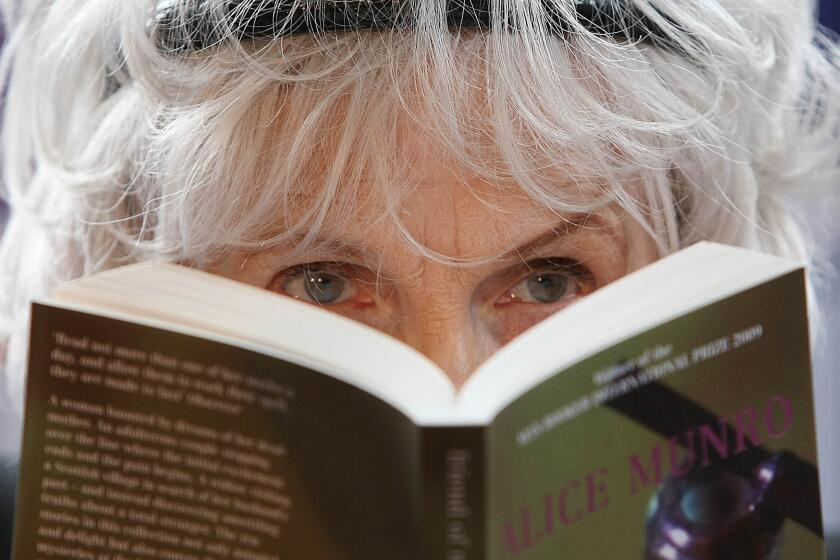War Stories Bound for Eternity
Camp Pendleton Marine base is one of those places we often drive past on the San Diego Freeway without giving much thought to what goes on there. When Robert W. Pierce of Anaheim drives by the base, he thinks back to more than 50 years ago.
For Pierce, Camp Pendleton was the beginning and the end of World War II. The events of the three years in between, when Pierce participated in some of the war’s bloodiest battles, are memories he has seldom shared except with those who lived them with him. Until now.
Pierce was with Company A of the First Armored Amphibian Battalion, the tank people who hit the beaches in the face of enemy firepower in the Marshall Islands, Guam and Okinawa.
Twenty-two years after the war’s end, the battalion began to hold annual reunions. Recently, its members decided to produce their own book, so others could learn more about their role in that important history, and how they viewed that role.
“We wanted something for our grandchildren, and our great-grandchildren,” Pierce said.
The book is titled “Hitting the Beaches.” Its 428 hardcover pages are a treasure for the families of its heroes, but also contain dramatic insights for the rest of us.
Mary Pierce, Robert Pierce’s wife of 51 years, told me: “I thought I knew my husband pretty well. But I learned things about him from reading that book that I never knew before.”
The volume was compiled by Dale L. Barker of Company D. But its authors are 47 men from the battalion--Pierce among them--whose personal stories provide the kind of detail you rarely see in standard history books. Barker has woven their pieces together in chronological order, from the Pendleton days, when the men could only guess what was ahead of them, to the beaches, and back to Pendleton, when the tank crews were anxious to make it home for Christmas.
Pierce, a Company A radio operator and machine gunner, wrote that in training exercises at the beach in Oceanside, “a number of times the tanks became waterlogged in the heavy surf.” But everybody knew there were more dangerous beaches ahead. Donald L. Ferchau of Company A called the tanks “floating coffins.”
The first battles, in the Marshall Islands, caused few tank casualties, because Navy firepower had successfully depleted the enemy forces before their arrival. But in Guam, the casualties were far greater.
“The Guam landing will remain in my memory forever,” Pierce wrote. “Our tank was the only survivor in our platoon. Three of four tanks were hit while on the reef approaching the beach at Agat. The fourth got ashore and was inland less than 50 yards when it was hit by a mortar shell. Our tank bellied up against a hillside.”
Surviving tanks were sent to the remote Orote Peninsula to try to knock out an enemy stronghold. That became another battle with heavy casualties. Pierce wrote: “I remember sobbing inside [the tank] as we removed our dead comrades from the machine gun hatches.”
One of those injured at Orote was Oliver Dowling of Rapid City, S.D. Dowling, who later ran a Holiday Inn there, hosted the first battalion reunion in 1977. Pierce has missed only four of the annual gatherings since then.
“When you’ve shared a tank in war with some of these guys, getting together is beyond just a family reunion,” Pierce said. “It’s really something indescribable.”
Mary Pierce suggested the book is more than just a collection of war stories. “What you see is the camaraderie, and the love, that these men had for each other.”
Fourth-Grade Review: Last week I suggested you write to a former teacher who may have influenced the direction of your life. Bradley Matter of Westminster writes me that he did that very thing six months before I brought it up.
Matter, a UPS deliveryman, wrote to Peggy Boortz, his fourth-grade teacher in Long Beach, after locating her through an Internet search. He hadn’t seen her since he went to school there 28 years ago.
“You had an impact. You stood out. You made a difference,” he wrote her. “You had a beautiful voice. I always looked forward to singing time, when we could hear you.”
Not only did Peggy Boortz write a nice letter back, she showed up for dinner with Matter and his wife, Kitty.
So Very Darned Proud: Dozens of people from Orange County attended the recent dedication of the Women Veterans Memorial near the entrance to Arlington National Cemetery in Washington. A couple shared their reactions with me.
One was Margaret Juneman of San Juan Capistrano, who met her husband, James, when both were in the Coast Guard during World War II.
“Just being with so many women--and being so darned proud of them all--was worth the trip,” Juneman said. “I met a lot of friends I hadn’t seen in years.”
Bonnie Barton of Garden Grove went on behalf of her mother, Helen Ross Fisher, and her mother’s best friend, known to Barton as “Aunt Opal.” Both women military veterans died within the last two years.
Barton was delighted to find both their names in the computerized registry at the memorial. Quite by accident, Barton later ran into Brig. Gen. Wilma Vaught, the driving force behind construction of the memorial built. Vaught asked Barton why she had come, and when Barton told the retired general about the two women veterans, Vaught “stretched out her arms with tears in her eyes and hugged me tight,” Barton said. That led to Barton’s own tears, which she had held back during the ceremonies.
Wrap-Up: You don’t have to know anyone in the First Armored Amphibian Battalion to be interested in its collection of anecdotes of front-line war. The first part of the book is also rich with detail about war training at Camp Pendleton. You can order the book by writing to the battalion at 2609 Flemington Road, Atlanta, Ga. 30345. The cost is $25 plus postage.
“We didn’t write it to make a profit,” Pierce said, “Just to share a few memories.”
Jerry Hicks’ column appears Tuesday, Thursday and Saturday. Readers may reach Hicks by call-ing the Times Orange County Edition at (714) 966-7823 or by fax to (714) 966-7711, or e-mail tojerry.hicks@latimes.com
More to Read
Sign up for our Book Club newsletter
Get the latest news, events and more from the Los Angeles Times Book Club, and help us get L.A. reading and talking.
You may occasionally receive promotional content from the Los Angeles Times.






